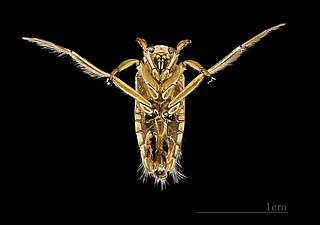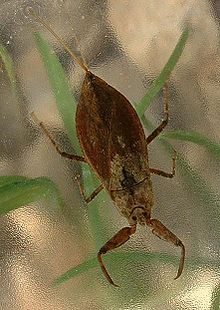
The Hemiptera or true bugs are an order of insects comprising some 50,000 to 80,000 species of groups such as the cicadas, aphids, planthoppers, leafhoppers, bed bugs and shield bugs. They range in size from 1 mm (0.04 in) to around 15 cm (6 in), and share a common arrangement of sucking mouthparts. The name "true bugs" is often limited to the suborder Heteroptera. Many insects commonly known as "bugs", especially in American English, belong to other orders; for example, the lovebug is a fly and the May bug and ladybug are beetles.

The Heteroptera are a group of about 40,000 species of insects in the order Hemiptera. They are sometimes called "true bugs", though that name more commonly refers to the Hemiptera as a whole. "Typical bugs" might be used as a more unequivocal alternative, since the heteropterans are most consistently and universally termed "bugs" among the Hemiptera. "Heteroptera" is Greek for "different wings": most species have forewings with both membranous and hardened portions ; members of the primitive sub-group Enicocephalomorpha have completely membranous wings.

The Plecoptera are an order of insects, commonly known as stoneflies. Some 3,500 species are described worldwide, with new species still being discovered. Stoneflies are found worldwide, except Antarctica. Stoneflies are believed to be one of the most primitive groups of Neoptera, with close relatives identified from the Carboniferous and Lower Permian geological periods, while true stoneflies are known from fossils only a bit younger. Their modern diversity, however, apparently is of Mesozoic origin.

Corixidae is a family of aquatic insects in the order Hemiptera. They are found worldwide in virtually any freshwater habitat and a few species live in saline water. There are about 500 known species worldwide, in 33 genera, including the genus Sigara.
Waterbug or water bug can refer to any of several things:

Nepidae is a family of exclusively aquatic Heteropteran insects in the order Hemiptera. They are commonly called water scorpions for their superficial resemblance to scorpions, due to their raptorial forelegs and the presence of a long slender process at the posterior end of the abdomen, resembling a tail. There are 14 genera in the family, in two subfamilies, Nepinae and Ranatrinae. Members of the genus Ranatra, the most widespread and speciose genus, are sometimes called needle bugs or water stick insects as they are slenderer than Nepa.

A leafhopper is the common name for any species from the family Cicadellidae. These minute insects, colloquially known as hoppers, are plant feeders that suck plant sap from grass, shrubs, or trees. Their hind legs are modified for jumping, and are covered with hairs that facilitate the spreading of a secretion over their bodies that acts as a water repellent and carrier of pheromones. They undergo a partial metamorphosis, and have various host associations, varying from very generalized to very specific. Some species have a cosmopolitan distribution, or occur throughout the temperate and tropical regions. Some are pests or vectors of plant viruses and phytoplasmas. The family is distributed all over the world, and constitutes the second-largest hemipteran family, with at least 20,000 described species.

Notonectidae is a cosmopolitan family of aquatic insects in the order Hemiptera, commonly called backswimmers because they swim upside down. They are all predators and typically range from 0.5 to 1.5 cm (0.2–0.6 in) in length. They are similar in appearance to Corixidae, but can be separated by differences in their dorsal-ventral coloration, front legs, and predatory behavior. Their dorsum is convex, lightly colored without cross striations. Their front tarsi are not scoop-shaped and their hind legs are fringed for swimming. There are about 350 species in two subfamilies: Notonectinae with seven genera, and Anisopinae with four genera. Members in the former subfamily are often larger than those in the latter.

Belostomatidae is a family of freshwater hemipteran insects known as giant water bugs or colloquially as toe-biters, Indian toe-biters, electric-light bugs, alligator ticks, or alligator fleas. They are the largest insects in the order Hemiptera. There are about 170 species found in freshwater habitats worldwide, with more than 110 in the Neotropics, more than 20 in Africa, almost as many in the Nearctic, and far fewer elsewhere. These predators are typically encountered in freshwater ponds, marshes and slow-flowing streams. Most species are at least 2 cm (0.8 in) long, although smaller species, down to 0.9 cm (0.35 in), also exist. The largest are members of the genus Lethocerus, which can exceed 12 cm (4.5 in) and nearly reach the length of some of the largest beetles in the world. Giant water bugs are a popular food in parts of Asia.

The Gerromorpha comprise an infraorder of insects in the "true bug" order Hemiptera. These "typical" bugs are commonly called semiaquatic bugs or shore-inhabiting bugs. The Ochteroidea are also found in shore habitat, while the Gerromorpha are actually most often encountered running around on the water surface, being kept from sinking by surface tension and their water-repellent legs. Well-known members of the Gerromorpha are the namesake Gerridae.

The Pentatomomorpha comprise an infraorder of insects in the true bug order Hemiptera. It unites such animals as the stink bugs (Pentatomidae), flat bugs (Aradidae), seed bugs, etc. They are closely related to the Cimicomorpha.

Notonecta glauca is a species of aquatic insect, and a type of backswimmer. This species is found in large parts of Europe, North Africa, and east through Asia to Siberia and China. In much of its range it is the most common backswimmer species. It is also the most widespread and abundant of the four British backswimmers. Notonecta glauca are Hemiptera predators, that are approximately 13–16 mm in length. Females have a larger body size compared to males. These water insects swim and rest on their back and are found under the water surface. Notonecta glauca supports itself under the water surface by using their front legs and mid legs and the back end of its abdomen and rest them on the water surface; They are able to stay under the water surface by water tension, also known as the air-water interface. They use the hind legs as oars; these legs are fringed with hair and, when at rest, are extended laterally like a pair of sculls in a boat. Notonecta glauca will either wait for its prey to pass by or will swim and actively hunt its prey. When the weather is warm, usually in the late summer and autumn, they will fly between ponds. Notonecta glauca reproduce in the spring.

Naucoridae is a small family of insects commonly known as the creeping water bugs and saucer bugs. They are similar in appearance and behavior to Belostomatidae, but considerably smaller, at 0.5–2 cm (0.2–0.8 in) long. Naucoridae are found around the world, but the greatest diversity is in tropical regions. They inhabit a wide range of freshwater habitats, ranging from still waters like ponds, to flowing rivers and even torrential streams. There are about 400 species in 40 genera in 5 subfamilies.

Pleidae, the pygmy backswimmers, is a family of aquatic insects in the order Hemiptera. There are 37 species in three genera, distributed across most of the world, except the polar regions and remote oceanic islands.

Lethocerus is a genus of the hemipteran family Belostomatidae, known colloquially as giant water bugs, distributed in tropical, subtropical and temperate areas of the world. The greatest diversity of species occurs in the Americas, with only a single species in Europe, two in Africa, two in Australia and three in Asia. It includes the largest true bugs with species capable of reaching a length of over 12 centimetres (4.7 in). The South American L. grandis and L. maximus are the only species to commonly exceed 9 cm (3.5 in), with more typical lengths for the remaining species being between 4.5 and 9 cm. Lethocerus sp. are distinguished from other genera in the Lethocerinae by two symmetrical furrows in the inner pad of setae on the fore femur, the external borders of parasternites II and III narrowed and nearly straight, and with the setae of the tarsomeres following the line of the tibial setae.
Sigara fallenoidea is a species of water boatman in the family Corixidae in the order Hemiptera.It was described by Hungerford and the type locality is in Canada. In Ireland Walton discovered a 'new' species of corixidae which he named Sigara pearcei. This was synonymised by Hungerford in 1950. The distribution of S. fallenoidea is therefore an extraordinary one including Canada, Ireland, Norway, Finland, Sweden, Ukraine and Russia. In Ireland, Sigara fallenoidea is found in all the large lakes on the island. There are confirmed records from Loughs Neagh, Beg and Portmore Lough; Upper and Lower Lough Erne; Lough Melvin; Loughs Ree, Derg and Key on the Shannon; and Lough Corrib.

Yuri Alexandrovich Popov was a Soviet and Russian paleoentomologist, an authority on the taxonomy and evolution of fossil true bugs (Heteroptera) and Coleorrhyncha. He described more than 20 new families and subfamilies and 300 new genera and species from the Mesozoic and Cenozoic. He also was one of the founders of the modern higher classification of true bugs: three of seven heteropteran infraorders have been established by him. He was the author of more than 170 publications, including a classic monograph on the evolution of water bugs.

Abedus is a genus of giant water bugs found in freshwater habitats in southern United States, Mexico and Central America. Sometimes called ferocious water bugs, these brown insects typically are between 2.3 and 4 cm (0.9–1.6 in) long, although A. immaculatus only is about 1.3–1.4 cm (0.51–0.55 in), making it the smallest North American belostomatid and possibly worthy of separation in its own genus. Otherwise the different Abedus species are very similar and can often only be separated with a microscope. They will bite in self-defense, which is painful but not dangerous.

Lethocerus patruelis is a giant water bug in the family Belostomatidae. It is native to southeastern Europe, through Southwest Asia, to Pakistan, India and Burma. It is the largest European true bug and aquatic insect. Adult females are typically 7–8 cm (2.8–3.1 in) long, while the adult males are 6–7 cm (2.4–2.8 in).
Buenoa is a genus of backswimmer. It was created by George Willis Kirkaldy in 1904 to include all species of Anisops from the Western Hemisphere with a two-segmented front tarsus in males, reserving the latter genus for Eastern Hemisphere species with a one-segmented front tarsus in males. It contains 69 described species.


















